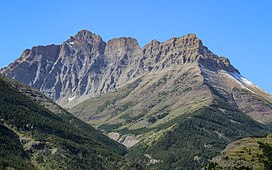| Mount Blakiston | |
|---|---|
 Mount Blakiston | |
| Highest point | |
| Elevation | 2,910 m (9,550 ft) [1] |
| Prominence | 1,149 m (3,770 ft) [2] |
| Parent peak | Kintla Peak 3071 m [2] |
| Listing | Mountains of Alberta |
| Coordinates | 49°05′39″N 114°02′06″W / 49.09417°N 114.03500°W [3] |
| Geography | |
| Parent range | Clark Range |
| Topo map | NTS 82G1 Sage Creek [3] |
| Climbing | |
| First ascent | Unknown [4] |
| Easiest route | Moderate scramble [5] |
Mount Blakiston is a mountain in the southwestern corner of Alberta, Canada and the highest point within Waterton Lakes National Park. The mountain is situated in the Clark Range, north of Lineham Creek and south of Blakiston Creek. Blakiston's closest neighbours include Mount Hawkins 2,685 m (8,809 ft) directly to the west along a connecting ridge and Mount Lineham 2,728 m (8,950 ft) to the south.
The mountain was named in 1858 for Thomas Blakiston, a member of the Palliser Expedition. [1] [6]
The Lineham Creek hiking trail passes along the foot of the southern slopes of the mountain and for capable scramblers, Blakiston's rubbly but steep southern slopes provide a suitable line of ascent. [5] An ascent in 1942 by J. Gibson and G. Williams found an unmarked cairn on the summit so the first ascent party is unknown. [4]
Geology
Like other mountains in Waterton Lakes National Park, Mount Blakiston is composed of sedimentary rock laid down during the Precambrian to Jurassic periods. Formed in shallow seas, this sedimentary rock was pushed east and over the top of younger Cretaceous period rock during the Laramide orogeny. [7]
Climate
Based on the Köppen climate classification, Mount Blakiston is located in a subarctic climate with cold, snowy winters, and mild summers. [8] Temperatures can drop below −20 C with wind chill factors below −30 C.
See also
References
- ^ a b "Mount Blakiston". cdnrockiesdatabases.ca. Retrieved 2019-08-19.
- ^ a b "Mount Blakiston". Bivouac.com. Retrieved 2008-07-13.
- ^ a b "Mount Blakiston". Geographical Names Data Base. Natural Resources Canada. Retrieved 2019-08-19.
- ^ a b Thorington, J. Monroe (1966) [1921]. "Akamina Pass to Tornado Pass". A Climber's Guide to the Rocky Mountains of Canada. With the collaboration of Putnam, William Lowell (6th ed.). American Alpine Club. p. 4. ISBN 978-1376169003.
- ^ a b Kane, Alan (1999). "Mount Blakiston". Scrambles in the Canadian Rockies. Calgary: Rocky Mountain Books. pp. 41–42. ISBN 0-921102-67-4.
- ^ Place-names of Alberta. Ottawa: Geographic Board of Canada. 1928. p. 21.
-
^ Gadd, Ben (2008). "Geology of the Rocky Mountains and Columbias".
{{ cite journal}}: Cite journal requires|journal=( help) - ^ Peel, M. C.; Finlayson, B. L. & McMahon, T. A. (2007). "Updated world map of the Köppen−Geiger climate classification". Hydrol. Earth Syst. Sci. 11 (5): 1633–1644. Bibcode: 2007HESS...11.1633P. doi: 10.5194/hess-11-1633-2007. ISSN 1027-5606. S2CID 9654551.
External links
- National Park Service web site: Waterton Lakes National Park
- Mt. Blakiston: Flickr photo

